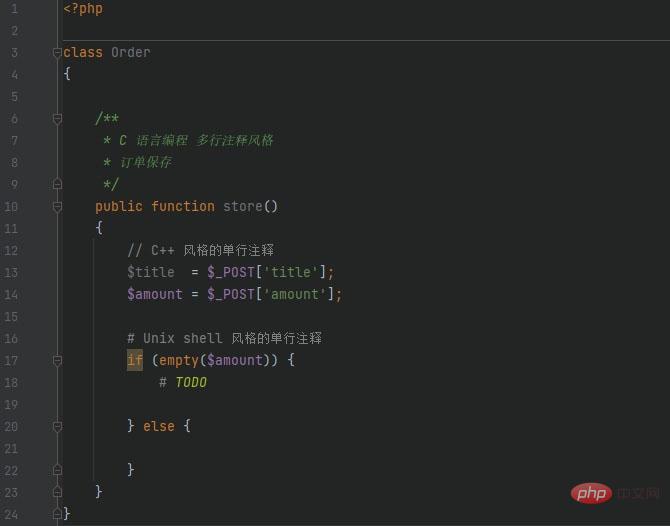Several aspects of content can be included in the .php file
Contents that can be included in the php file: 1. The starting tag "", all PHP code must be written inside this pair of tags; 2. The semicolon ";" is the PHP statement The delimiter also represents the instruction for code execution; 3. Comments, including single-line comments "//", multi-line comments "/* */", and Shell comments "#"; 4. Line breaks, which can be enhanced Code readability; 5. Code segments (such as functions, etc.).

The operating environment of this tutorial: windows7 system, PHP8 version, DELL G3 computer
PHP is a super text preprocessing language ( Abbreviation for Hypertext Preprocessor).
What is a php file?
The name format of a php file is a programming language format, more technically speaking, a scripting language embedded in HTML text , the language style is similar to C language, and the syntax combines C, Perl, Java and PHP's own innovative syntax forms, and is often widely used by website programmers. This kind of file is generally executed on the server side, which can fully utilize the performance of the server and execute dynamic web pages faster than CGL and Perl. Its execution engine can also keep frequently accessed programs in the memory so that the user can access them next time. There is no need to recompile the program, just execute the retained code directly, which is very efficient.
The most powerful feature of the php file is its database integration layer. With this feature, it becomes very simple to use php files to create a web page with a database. The function of the php file also depends on its Compatibility with various databases, in addition to using HTTP communication, php files can also use IMAP, SNMP, POP3 and NNTP protocols.
How many contents does the php file contain?
1. Start and end tags. All PHP code must be written inside this pair of tags.
// 起始标签 <?php // 结束标签 ?>
2. ";": The semicolon is the delimiter of PHP statements. Also represents the instructions for code execution
$name = 'PHP中文网'; echo $name;
3. Comments:
PHP supports 3 comment styles: C, C and Unix Shell style (Perl style)
① Single-line comment (C style), symbol: //
②Multi-line comment (C style), symbol: /* */
③Special single-line comments (not commonly used, Shell style), symbol:
<?php echo "单行注释" ;//一般在代码右边少量说明或写在代码前面使之失效 echo "多行注释" ; /* 一般说明脚本的相关信息,如版本,版权,作者日期等 使一长段代码失效 */ echo "单行注释" ;#一般在代码右边少量说明或写在代码前面使之失效 ?>

Description: Single-line comments only Comment to the end of the line or the current PHP code block (even if there is "?>" at the end of the line, it will not be commented. When PHP encounters "?>", it will jump out of PHP mode and then parse the HTML code or other)
4. Newline characters
Appropriately add newline indentation between statements to enhance the readability of the code
// 可读性较差 $name = 'PHP中文网';echo $name; // 适当加上换行可读性会更好 $name = 'PHP中文网'; echo $name;
5. Code segments (such as functions...)
function sum(int $a, int $b){
// return意思是返回结果给调用者
return ($a+$b);
}
// 执行,在客户端打印结果并输出
echo sum(10,20);Recommended learning : "PHP Video Tutorial"
The above is the detailed content of Several aspects of content can be included in the .php file. For more information, please follow other related articles on the PHP Chinese website!

Hot AI Tools

Undresser.AI Undress
AI-powered app for creating realistic nude photos

AI Clothes Remover
Online AI tool for removing clothes from photos.

Undress AI Tool
Undress images for free

Clothoff.io
AI clothes remover

AI Hentai Generator
Generate AI Hentai for free.

Hot Article

Hot Tools

Notepad++7.3.1
Easy-to-use and free code editor

SublimeText3 Chinese version
Chinese version, very easy to use

Zend Studio 13.0.1
Powerful PHP integrated development environment

Dreamweaver CS6
Visual web development tools

SublimeText3 Mac version
God-level code editing software (SublimeText3)

Hot Topics
 1377
1377
 52
52
 PHP 8.4 Installation and Upgrade guide for Ubuntu and Debian
Dec 24, 2024 pm 04:42 PM
PHP 8.4 Installation and Upgrade guide for Ubuntu and Debian
Dec 24, 2024 pm 04:42 PM
PHP 8.4 brings several new features, security improvements, and performance improvements with healthy amounts of feature deprecations and removals. This guide explains how to install PHP 8.4 or upgrade to PHP 8.4 on Ubuntu, Debian, or their derivati
 Discuss CakePHP
Sep 10, 2024 pm 05:28 PM
Discuss CakePHP
Sep 10, 2024 pm 05:28 PM
CakePHP is an open-source framework for PHP. It is intended to make developing, deploying and maintaining applications much easier. CakePHP is based on a MVC-like architecture that is both powerful and easy to grasp. Models, Views, and Controllers gu
 CakePHP File upload
Sep 10, 2024 pm 05:27 PM
CakePHP File upload
Sep 10, 2024 pm 05:27 PM
To work on file upload we are going to use the form helper. Here, is an example for file upload.
 How To Set Up Visual Studio Code (VS Code) for PHP Development
Dec 20, 2024 am 11:31 AM
How To Set Up Visual Studio Code (VS Code) for PHP Development
Dec 20, 2024 am 11:31 AM
Visual Studio Code, also known as VS Code, is a free source code editor — or integrated development environment (IDE) — available for all major operating systems. With a large collection of extensions for many programming languages, VS Code can be c
 CakePHP Quick Guide
Sep 10, 2024 pm 05:27 PM
CakePHP Quick Guide
Sep 10, 2024 pm 05:27 PM
CakePHP is an open source MVC framework. It makes developing, deploying and maintaining applications much easier. CakePHP has a number of libraries to reduce the overload of most common tasks.
 How do you parse and process HTML/XML in PHP?
Feb 07, 2025 am 11:57 AM
How do you parse and process HTML/XML in PHP?
Feb 07, 2025 am 11:57 AM
This tutorial demonstrates how to efficiently process XML documents using PHP. XML (eXtensible Markup Language) is a versatile text-based markup language designed for both human readability and machine parsing. It's commonly used for data storage an
 Explain JSON Web Tokens (JWT) and their use case in PHP APIs.
Apr 05, 2025 am 12:04 AM
Explain JSON Web Tokens (JWT) and their use case in PHP APIs.
Apr 05, 2025 am 12:04 AM
JWT is an open standard based on JSON, used to securely transmit information between parties, mainly for identity authentication and information exchange. 1. JWT consists of three parts: Header, Payload and Signature. 2. The working principle of JWT includes three steps: generating JWT, verifying JWT and parsing Payload. 3. When using JWT for authentication in PHP, JWT can be generated and verified, and user role and permission information can be included in advanced usage. 4. Common errors include signature verification failure, token expiration, and payload oversized. Debugging skills include using debugging tools and logging. 5. Performance optimization and best practices include using appropriate signature algorithms, setting validity periods reasonably,
 PHP Program to Count Vowels in a String
Feb 07, 2025 pm 12:12 PM
PHP Program to Count Vowels in a String
Feb 07, 2025 pm 12:12 PM
A string is a sequence of characters, including letters, numbers, and symbols. This tutorial will learn how to calculate the number of vowels in a given string in PHP using different methods. The vowels in English are a, e, i, o, u, and they can be uppercase or lowercase. What is a vowel? Vowels are alphabetic characters that represent a specific pronunciation. There are five vowels in English, including uppercase and lowercase: a, e, i, o, u Example 1 Input: String = "Tutorialspoint" Output: 6 explain The vowels in the string "Tutorialspoint" are u, o, i, a, o, i. There are 6 yuan in total




